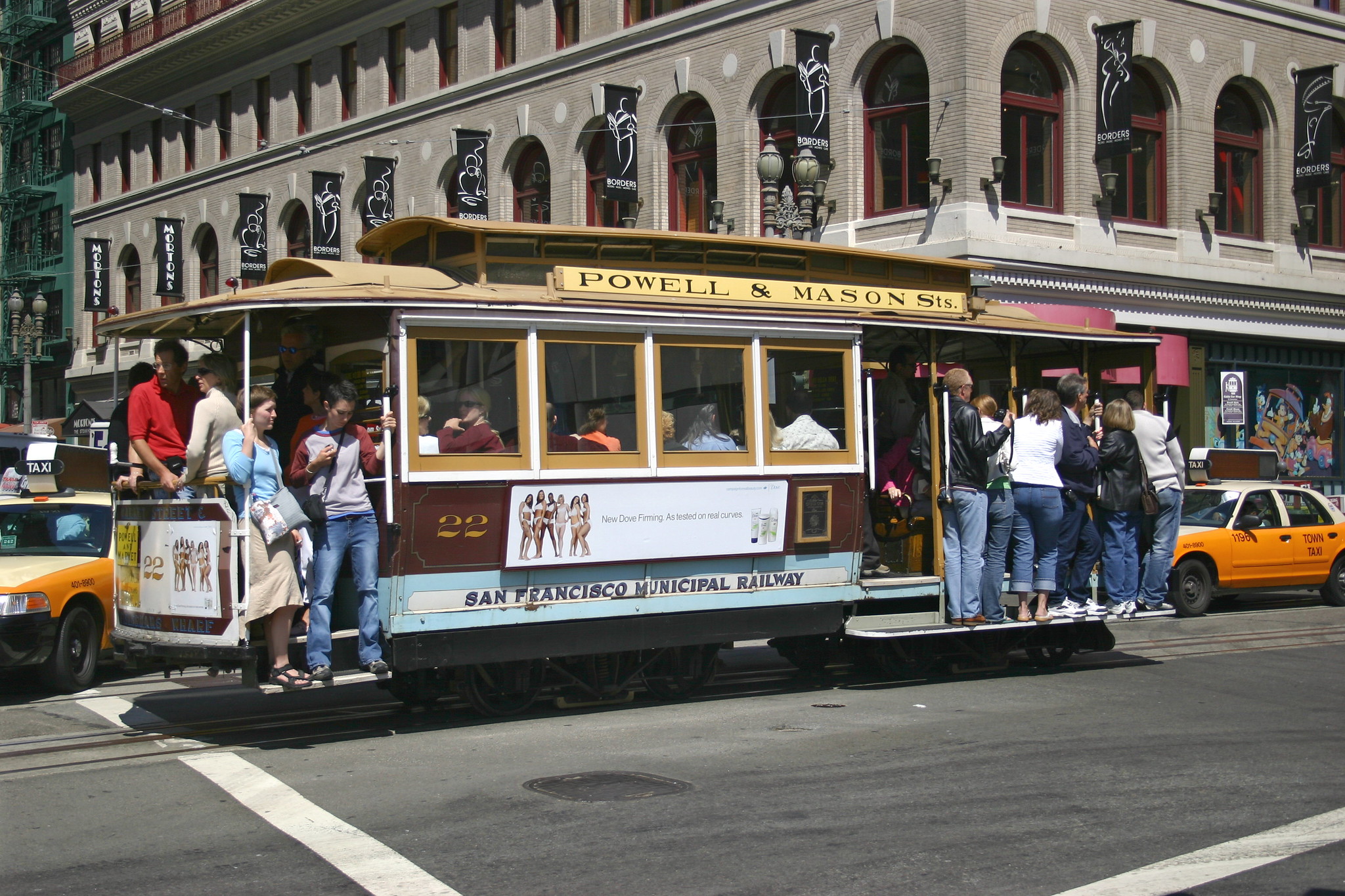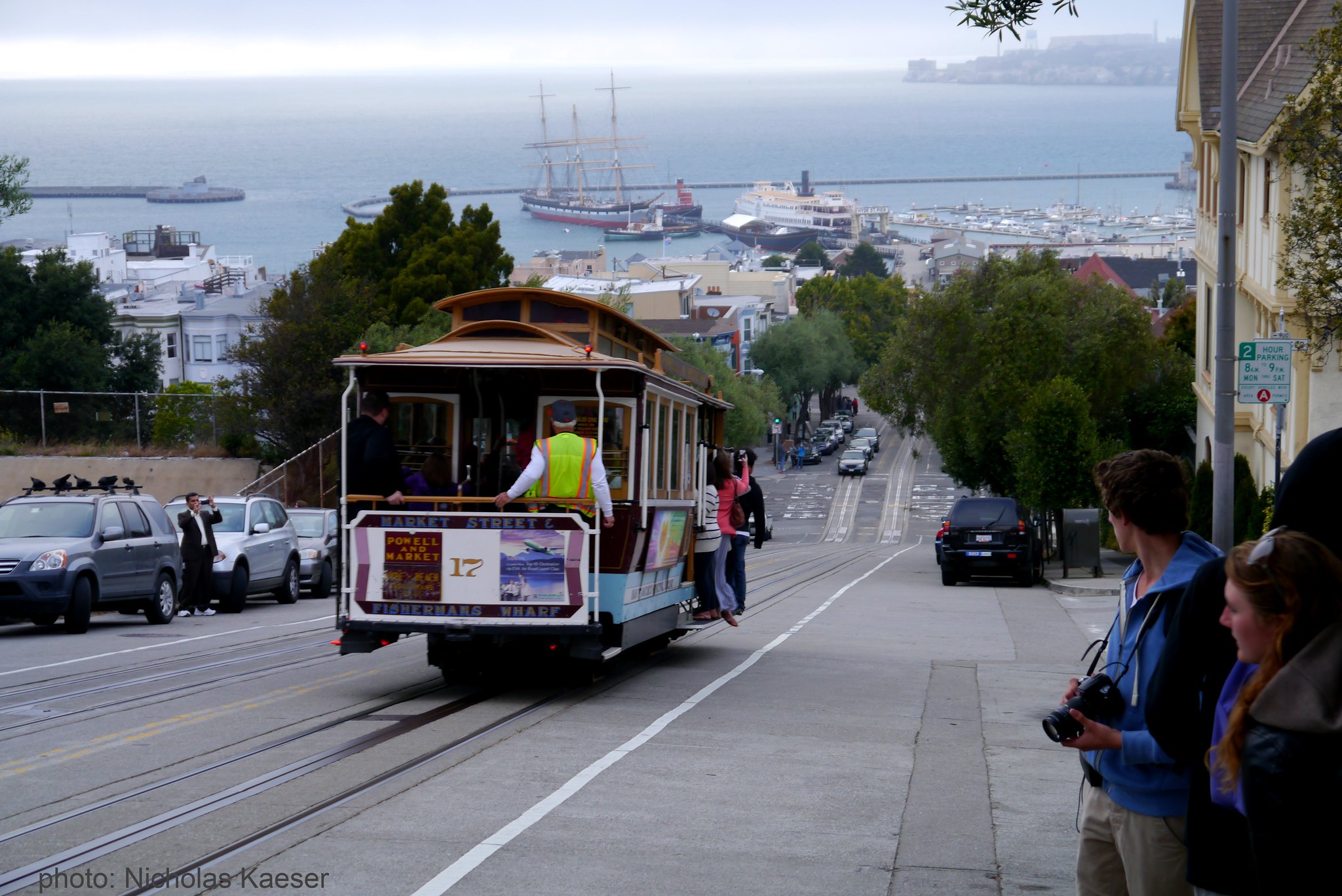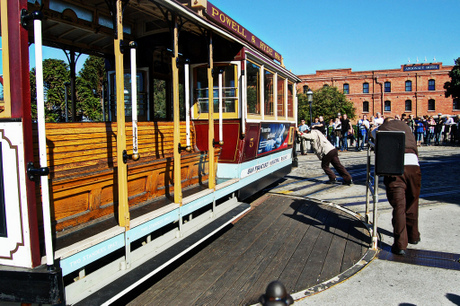Discovering the Adventure
San Francisco Cable Cars
Do You Know
Why San Francisco Cable Cars Were Created?
San Francisco cable cars started with an accident! In the beginning, San Francisco's public transportation system consisted of horse-drawn streetcars. In most cities around the world, this mode of transportation was quite adequate, but on the slippery cobble-stoned hills of San Francisco, it could turn deadly.
It's said that one damp, foggy Summer's day, Andrew Smith Hallidie was horrified as he watched a horse-drawn streetcar start to slide backwards down the hill as the hooves of the draft horses failed to maintain a grip on the slippery stones.
Five horses died that day, and Hallidie vowed to do something about it.
He and his partners established the first San Francisco cable car line, which was pulled up the hills by a system that gripped onto a constantly moving underground cable. Although Hallidie did not invent the cable car system, his design worked so well that it became the model for future cable car systems around the world.
What Exactly Are San Francisco Cable Cars?
They're vehicles like open-sided buses which are transported by means of a constantly moving underground cable, a grip, and a track.
The
grip grasps onto the cable, the cable moves continuously, and when a
car is gripped to the cable, the car moves along the track.
When the grip man determines it's time to go, he uses a lever which causes the grip (a vice-like thingy) to grasp the underground cable very firmly so the car is pulled along the track.
Time to stop? The grip man releases the grip, the cable is no longer engaged, and the brake lever is applied.
The reason Hallidie's design was so popular: he used a wire rope cable which did not wear out like regular rope cables previously used.
It's a pretty simple concept, but it sure solved the problem of horses
trying to pull heavy wagons up those San Francisco hills with their
hooves slipping on the rain and fog soaked cobblestone streets in the
1800s!
There Are Only 3
San Francisco Cable Car Lines Still Running
- The Powell-Hyde Line starts at the Powell and Market turntable, travels north along Powell over Nob Hill to the Hyde and Beach turntable in Fisherman's Wharf - The views from the tops of the hills are amazing!
- The Powell-Mason Line also starts at the Powell and Market turntable and travels north along Powell, but switches to Mason, and ends at the Aquatic Park turntable near Ghirardelli Square
- The California Line travels east and west from the Financial District (California and Market), through Chinatown and over Nob Hill, to Van Ness Avenue. This is the oldest cable car line still in operation. It differs from the other lines in that it uses double-ended cars, so - no turntables.
The interesting thing about the turntables is that they're still operated by manpower. Here's how it works: the car coasts onto the turntable; the conductor, the grip man, and a helper push the car to get the turntable turning; then - when the car is facing the right direction - they push the car off the turntable, onto the tracks, so it can head back along the way it just came.
In the days of long ago, riders and standers-by would help to turn the car, but alas - the dangers of lawsuits and insurance rules put a stop to the practice long before my days in The City!
To learn more about San Francisco cable cars, be sure to visit the Cable Car Museum. It's located in the historic Cable Car Barn and Powerhouse at 1201 Mason Street. You'll actually see the cable winding machinery in action! Best of all - it's free!
If you've ever enjoyed the thrill of riding a cable car in The City, hanging on to one of the special poles with the wind blowing your hair and the grip man's bell chiming in your ear...
Or if you still hope to get that chance - you can thank Friedel Klussman and her Citizens' Committee to Save the San Francisco Cable Cars for the opportunity. It was 1947 and The City was going to retire the system for good when Mrs. Klussman stepped in and organized the effort to preserve what was left.
Just be sure to heed the grip man when he says, "Step up! Step up!" Otherwise you might be sideswiped by another cable car or one of the many other obstacles along the way!
Do you have a favorite
NorCal story?
From a family visit from years ago to something
you discovered last weekend,
Share it with
the rest of us - we'd love to learn about it!
Follow the links in the right-hand column for more SF attractions.
Follow the links below to discover more about San Francisco, beyond the most famous tourist attractions:
- San Francisco Neighborhoods
Our favorite part of The City - San Francisco Nude Beaches
Who knew? - Things To Do in San Francisco
Some of them are free!
Please continue your exploration of what Northern California has to offer by using the Nav Bars in the left and right columns or by using the links at the bottom of the page.
Like what you're finding here at Discovering Northern California? Then please share with the Social Network of your choice.
And thanks for coming!
Related Pages
San Francisco Attractions
Alcatraz Island
Cable Cars
Chinatown
Coit Tower
Fishermans Wharf
Golden Gate Bridge
Union Square
Union Street
Related Pages
San Francisco
Discover San Francisco
SF Attractions
SF During the Gold Rush
1906 SF Earthquake
SF Neighborhoods
SF Nude Beaches
SF Things To Do
Related Pages
California Gold Rush
California Gold Rush
Discovery of Gold
Getting to California
Gold Rush Trail
Gold Rush Sites
Gold Panning
Related Pages
Northern California Beaches
Related Pages
Bay Area
1906 Earthquake
Alameda County
Contra Costa County
Marin County
San Francisco
San Mateo County
Santa Clara County
Solano County
Related Pages
Hints & Tips
Beach Safety Tips
Best Kept Travel Secrets
Family Camping Tips
iPhone Travel Apps
Nude Beaches
Tide Pool Tips
Travel Sites We Love
Travel Tips
Whale Watching Tips
Wine Tasting Tips
Winter Driving Tips
Related Pages
Things To Do
Activity Village
Attractions
Beaches
Beer Lovers Delight
Burney Falls
Camping
Casa de Fruta
Day Trips
Gold Panning
Gold Rush Sites
Healdsburg
Historic Grass Valley
Lake Shasta Caverns
Lodi
Missions
Nevada City
RV Destinations
Ski Resorts
Tide Pool Tips
Travel Tips
Weekend Trips
Whale Watching
Wine Tasting
Related Pages
Free Things To Do
Free in Big Sur
Free in Chico
Free in San Francisco
Free in Sonoma
Related Pages
Insider Secrets
Best Kept Travel Secrets
Best Winter Whitewater
Boring Road? Nope
CA Admission Day
Climbing at Castle Rock
Crabbing Spots
Dream of Dreams
Fall in Eastern Sierras
Ghost Stories
Glass Beach
Great Stays, Low Pays
How to be a Valley Girl
Jade Beach
Lake Shasta Caverns
Lassen Volcanic SP
Lost Coast
Mono Lake
Moss Landing: Whales
New Clairvaux Abbey
Panning for Gold
Pygmy Forest
Mendo to Eureka
RV Destinations
SF Great Places to Eat
SF: More About Eating
SF Neighborhoods
SF Giants Baseball
Santa Cruz: Memories
Santa Cruz: Old Friends
Sonoma Cooking Class
Sonoma History
Sonoma Top Wine Stop
Tahoe: Discovery Trail
Underground Gardens
Yosemite: Family Hikes
Yosemite: High Country
YNP: Off the Beaten Path
Yosemite: Taft Point
Ziplines


